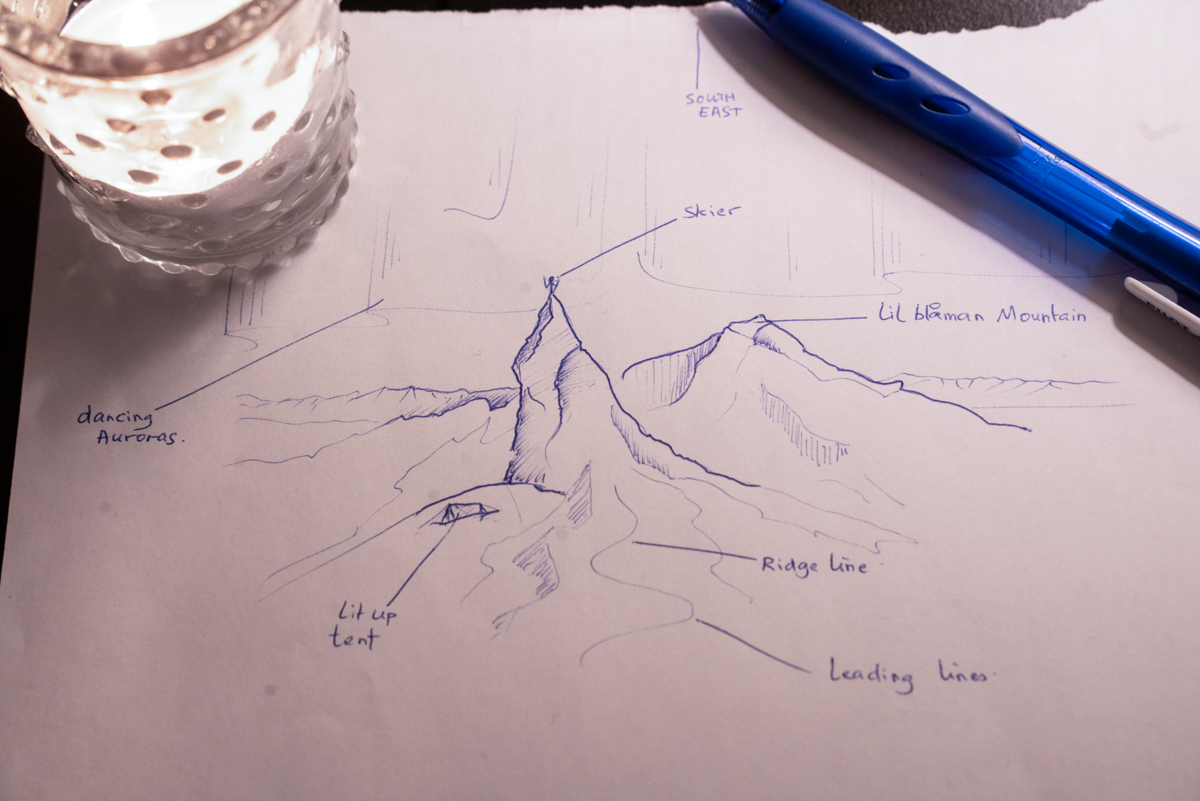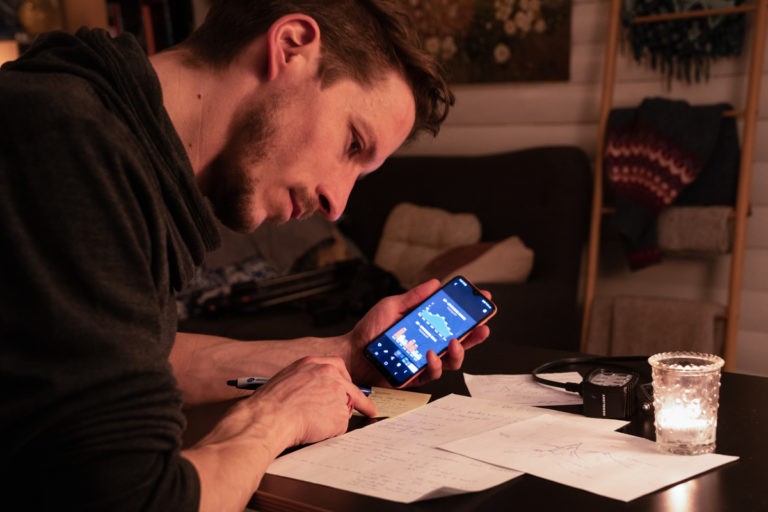Do you have a dream of making that perfect shot? The one nobody else has made before. The award-winning photographer Virgil Reglioni and his friend Florian Ledoux planned for that special shot for a year and a half. They went to “the Tooth” – a rock formation in the rugged mountains just west of Tromsø. The site is only accessible for good backcountry skiers. But to get it right, they needed both Northern Lights activity and the right kind of weather. Here is their story of the 2022 Unique Aurora Shot
I am Virgil Reglioni, 33 years old. I come from a small town between Lyon, in France, and Switzerland. I have spent the last six winters working as an outdoor nature guide and aurora photographer in the Arctic. After discovering Lapland, Finland, for the first time in 2016, I witnessed my first Northern lights and got hooked with night photography and especially the auroras. This unique niche of photography has now become my signature.
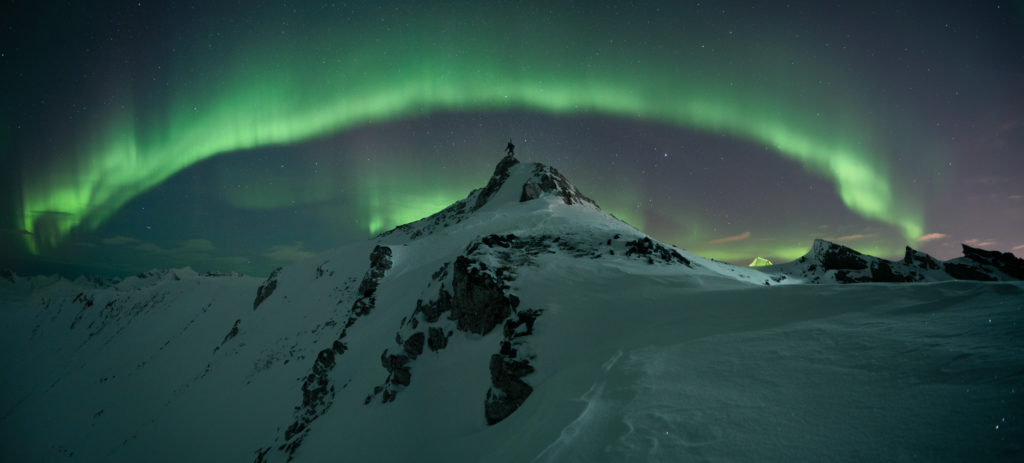
I want to catch a motif for the first time
I simply adore exploring and finding new places. Be it inaccessible, deep valleys or mountain tops. I try to catch aurora photographs never taken before, to see the unseen. I want to capture the Northern Light in a way we never see it, to be able to demonstrate its uniqueness and spontaneity. Searching for and composing impactful aurora photographs with the help of good organising, planning and profound creativity has become my first priority.
Fine art Aurora Photography is some of the most difficult photography around
To me, Fine Art Aurora Photography is one of the most complex styles of landscape and night photography. This is because it brings together a vast amount of knowledge about the aurora, the weather, the locations, and of course technical photography. Plenty of patience, creativity, photography skills, frustration, and perseverance are needed.
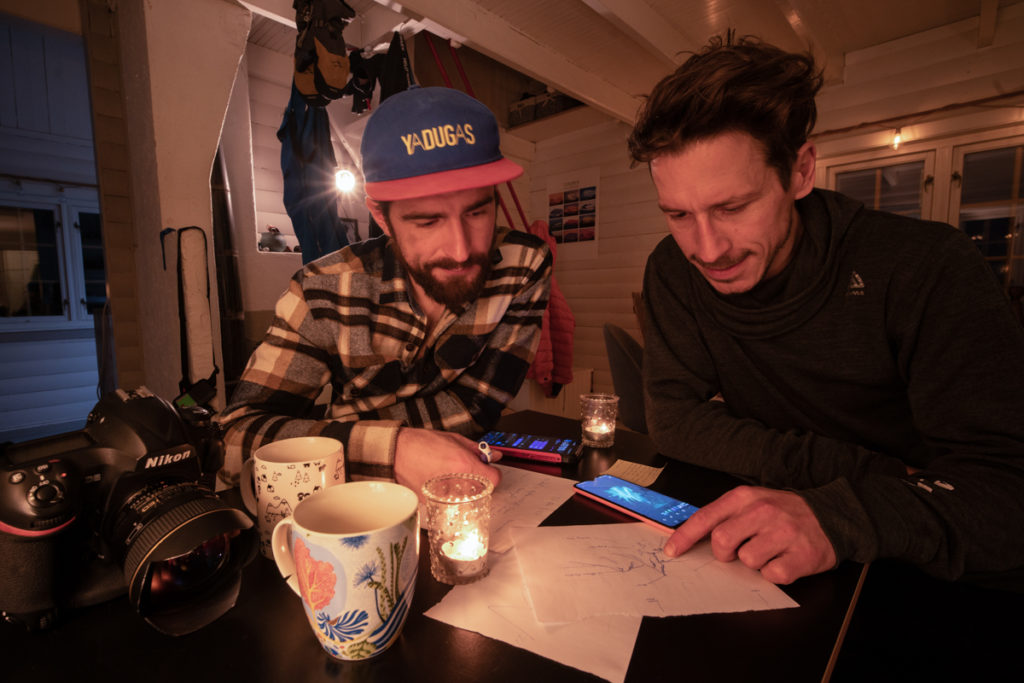
A crazy idea was born
We had studied this place for a long time and got this idea one and half year ago. Florian Ledoux, my best friend here in Tromsø, had spent many hours and many ski tours up on this mountain top on the western side of Tromsø city. He kept showing me some nice phone photos of the impressive mountain formation. That gave me this insane idea. Why don’t we try to get you up there, standing on the top of this Tooth, with some dancing aurora behind us, Tromsø city lights in the back, and our tent lit up on the side? It sounded like a dream shot to me, but not the easiest to plan and to achieve. We both agreed this could be our project for the winter.
What gear was needed?
The project got stuck in our mind and we started to plan. Equipment needed would include avalanche safety gear, a shovel and a search device. Also, a tripod and strong headlamps would be needed for the camera. To stay warm, we brought sleeping bags resistant down to -30C and a tent for shelter. We couldn’t know how long the wait would be. Finally, a change of clothers would be needed. After skiing 750 metres up, we would be sweating heavily. All in all, it would amount to 25 kg on our backs.
We needed a radio to communicate
Once standing apart from each other with Florian, we knew that communication could have been an issue because I would be staying at the bottom of the tooth, and he would be standing up there, exposed to the wind. We therefore took with us some VHF radios to be able to speak to each other.
The aurora intensity should be at a certain level
To be able to capture the aurora correctly, we had to understand what direction we were facing to be able to calculate what intensity of Northern lights we needed. When we know what aurora index we would need, we’d know what night to go. After studying the exact spot where I wanted to take the photo from, I figured out that I would be facing toward east/southeast. We concluded we would need a KP index of 3/4 out of 9.
Aurora forecasts were studied intensely
Once this was decided, we would have to keep a constant eye on the aurora forecasts during the upcoming weeks. Then we could find the right night to launch the battle plan. The weather should also be perfect, and we should also both be off work.
What would the perfect weather be?
We needed to have completely clear skies to be able to see the lights. If clouds were to roll in, they would cover the sky and stop us from seeing them. Since our mountain of choice is so close to Tromsø, we needed a completely clear sky. This was to avoid light pollution bouncing off even the tiniest cloud. On top of this, we wanted to avoid any wind. Staying in the cold under 20 degrees below zero for 4 or 5 hours can be really exhausting.
We didn’t want to stay up there too long
We wanted to minimise the time spent up there. Under really cold conditions, standing still for hours is tough, tiring, and boring. We’d thus be less productive and efficient. Therefore, we should either reduce the outdoor time or making it more comfortable for ourselves. On the other hand, we would be needing time to get up there. We would also need time up there to prepare for the shot. This would include finding the right angle, finding a good path up to the cliff and bringing it all together in a good composition. All this before the show started. So, not too soon and not too late.
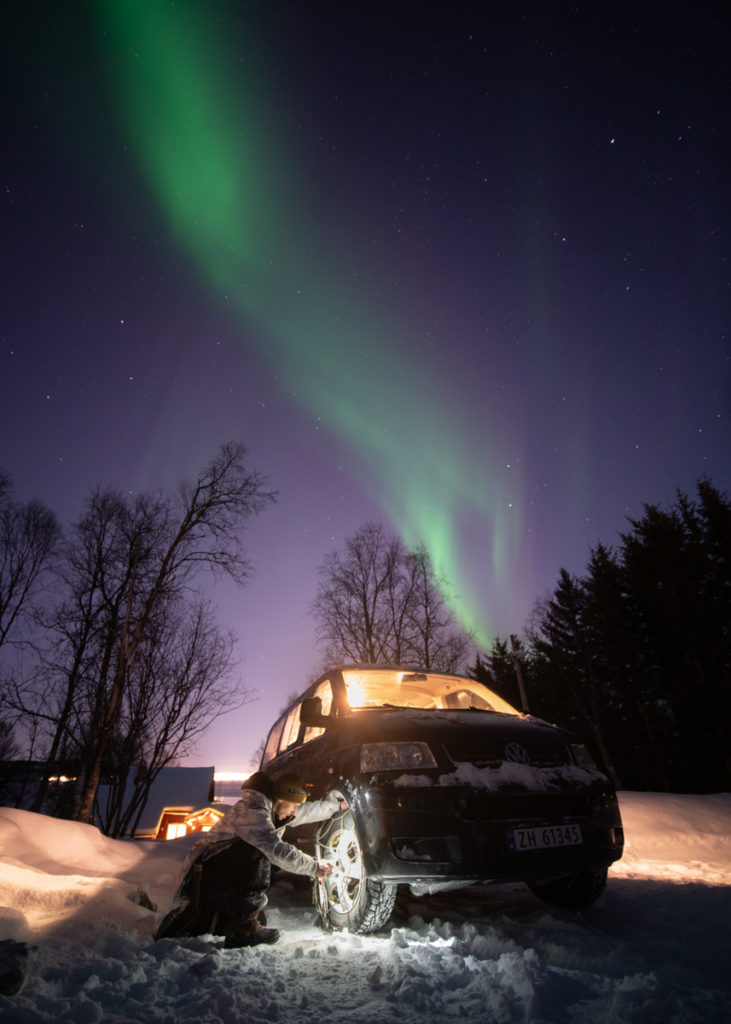
We made the first attempt on February 2nd 2022
In the afternoon we geared up We started the hike about 18.30 and reached the top around 20h in search of all the elements we needed, thoroughly planned earlier. As predicted, the sky was clear when we arrived. We spent one hour looking around when we reached the top, trying to find the best place for the tent, where to position myself and my tripod, and finding the right composition.
The route to the Tooth was icy
Meanwhile, Florian went looking for a route to the top of the tooth. We had a first issue, as there was a layer of thin snow covering a hard icy layer, making the way up there hard and slippery without crampons or an ice axe.
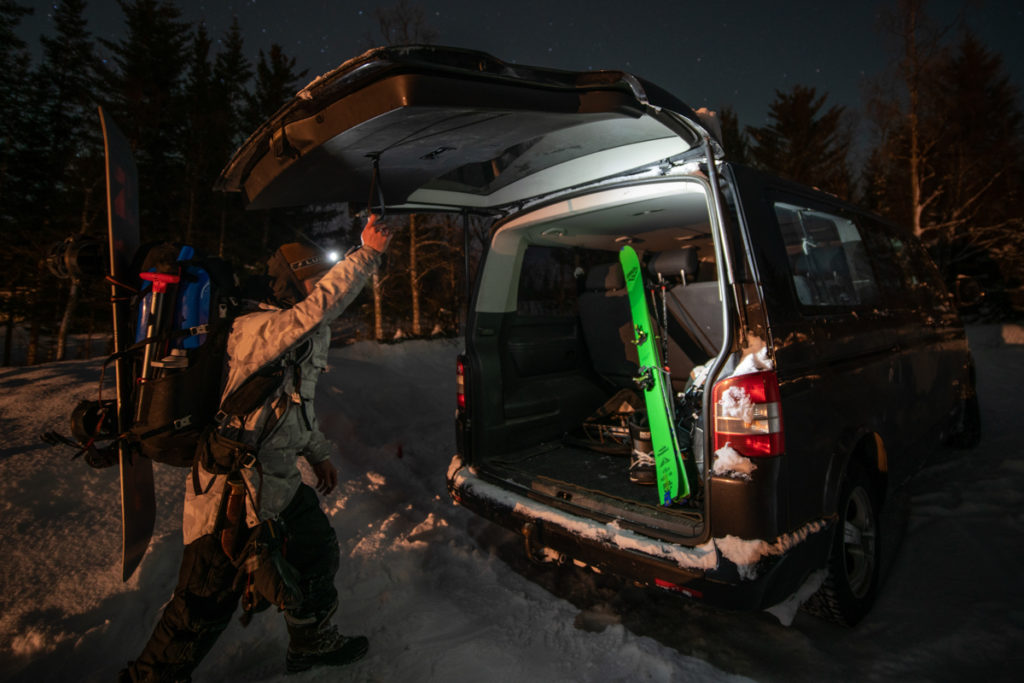
Wind made us give up the attempt
After 4.5 hours waiting, sheltered in the tents, the wind picked up heavily, sending snow drift toward us, on top of our gears and the tent, pushing us to pack fast and move away from our location to ride down and reach the bottom of the mountain under really bad snow conditions.
Aurora was playing with us
Strong Aurora Borealis was predicted. However, when the oval of Northern lights did hit, it did so on the other side of the planet. The lucky people in Northern Canada and Alaska could watch incredible displays this night. The weather forecast turned out to be quite wrong, there were more clouds than expected. Also, the wind picked up to around 13 to 15 metres per second around 1 o’clock in the morning. A lot of snowdrift made it really uncomfortable to capture images or even unpacking our equipment.
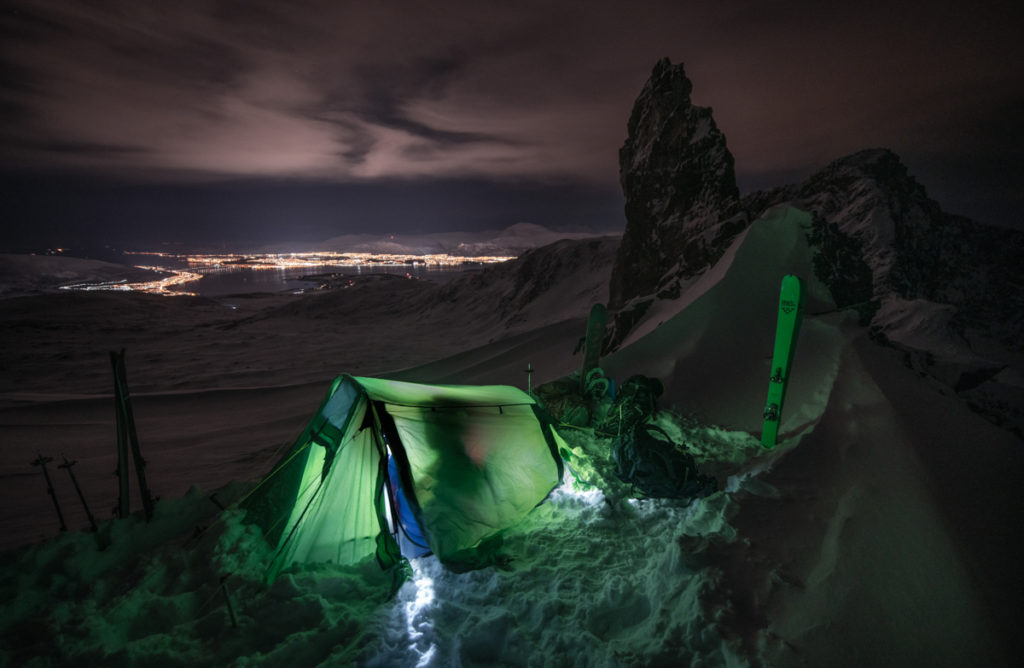
The first attempt was a learning experience
We realised that we needed ice axes and crampons for the next attempt. The ice conditions are highly volatile. All in all, we gathered valuable information, and a safe way to the pinnacle was located. We also found the perfect place for the tent, to avoid footprints in the snow. All in all, I found the main outline for my composition.
The right camera setting was explored
I use a Sony A7RII, with a wide angle lens of 15mm. The aperture is 2.0. One factor was the light pollution from Tromsø which affected the setting. My idea was to take the same photo several times on different exposures. Then the city lights would be well exposed, and I could make a panorama. I planned in a total of six shots together, all taken within a few seconds. That way, I would capture the same light conditions and the same aurora movements in one.
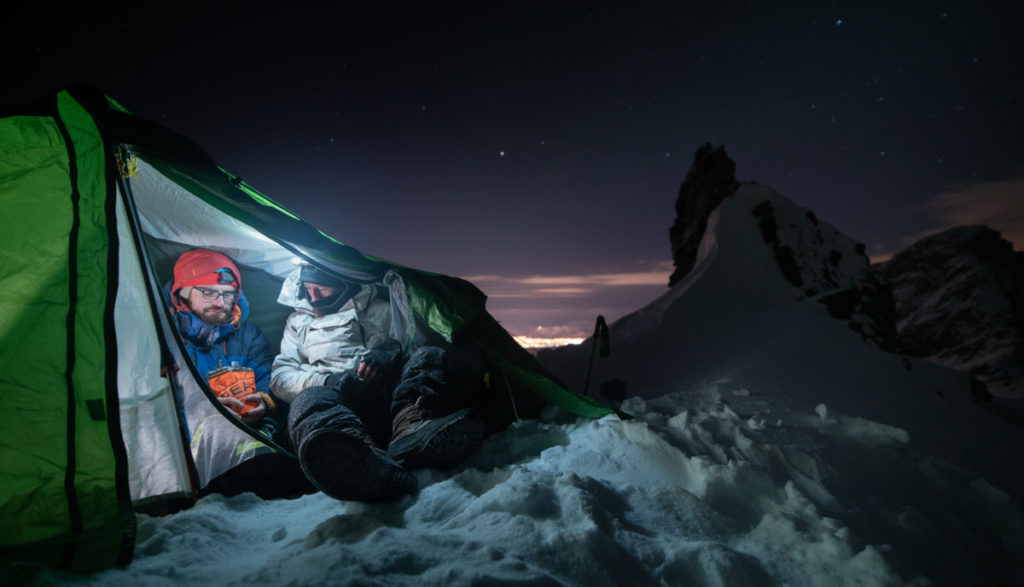
The composition of the photo was carefully planned
My main object was the Tooth-shaped cliff, which I planned to position in the centre. That way it would stand out. If positioned left-of-centre, the Tooth would be one of many cliffs, it wouldn’t be as impressive. The tent should then be lit up and placed a little to the left, showing the night scene in its proper context.
The second time, February 21st, things worked out
All the stars on the night sky greeted us on this night. It took us about one and a half hour to ski up the mountain and setting up camp. The aurora wasn’t out yet, giving us time to look around, observing snow conditions and the right orientation. All in all, we spent six and a half hours outside that night. The temperature, including the windshield factor, was a crazy -27. We kept as warm as we could with hot food in the tent.

The cold affected the lenses
Throughout the night, the cold affected the photographing. I switched lenses all the time to get a good mix of wide angle shots and some close-ups. Depending on where Aurora moved, I kept switching lenses, maybe I did it 16-17 times. My fingers were cold, and I got unwanted scratches on both of my lenses. Occasionally, I couldn’t even press the button, as my fingertips were totally numb.
The first photos were on the opposite side
The first few photos were taken with Aurora dancing in the north. I got some of the most impressive panorama shots I had ever taken. However, we still waited patiently for the Northern Lights to move to the southeast. Then we would see Aurora dance behind the Tooth.
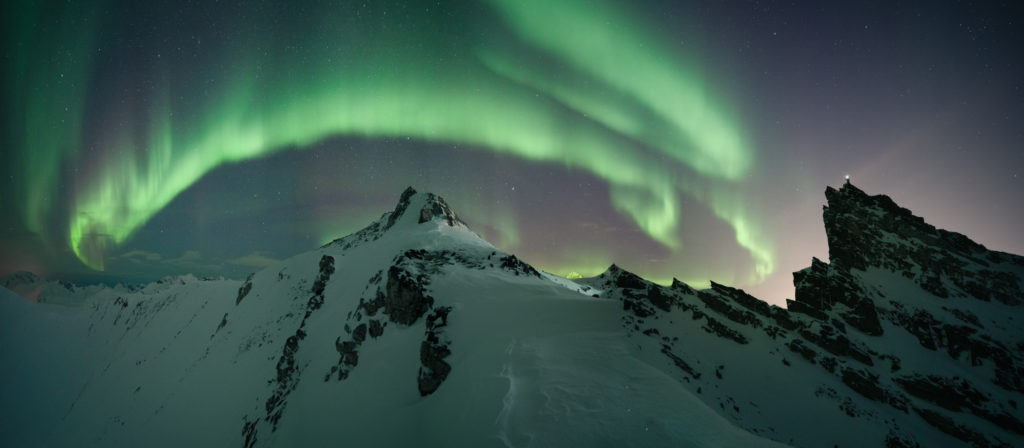
What does the landscape look like from the air?
From the top of the Tooth, Florian launched his drone. He could then capture the full perspective of the landscape, taking in the jagged peaks around us. On the capture above, you can see our camera set up from above. Florian is atop the Tooth with his strong light. The tent is on the left side, and I, Virgil, is photographing on the snowy ridge below.
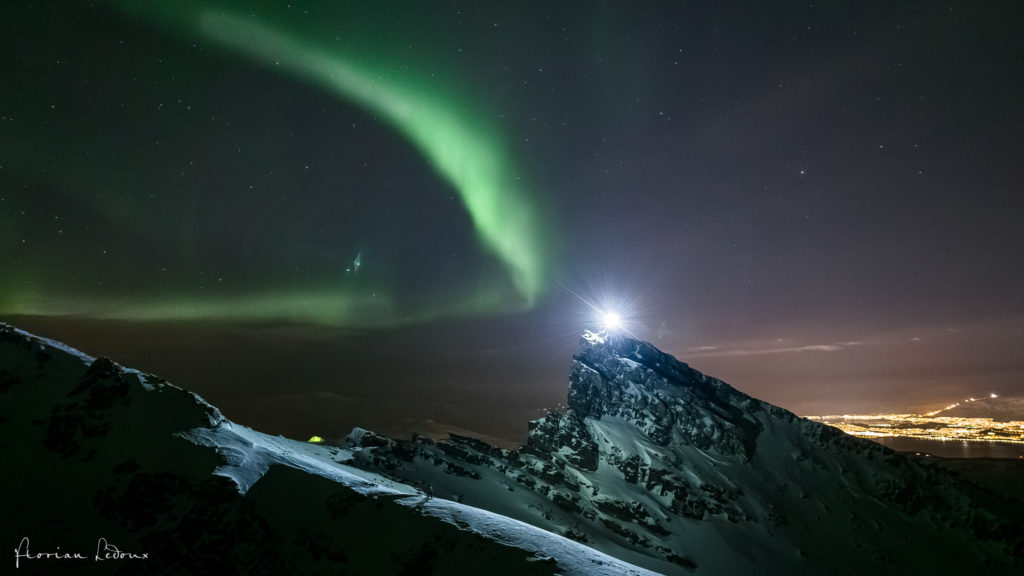
How to capture Florian on top of the Tooth
Having a photo wirh Florian on the top of the Tooth was one of the most important things. I managed to gather this image around 10pm. We see the full oval of light from the northwest to northeast. Florian is standing out from the top of the Tooth on the right side with his head torch on.
Florian needed to move
During the evening, I realised I had to adapt the composition. If Florian would be on top of the Tooth, I wouldn’t be able to see the whole of his figure. The legs would be missing. Instead, I decided to place him on the side. This would create a better balance. The photo would be a triangle with the tent and the city to the left, the tooth in the middle and the skier on the right.
Voilà; this is my 2022 Northern Lights capture
This panorama is one of my best aurora works. Shooting images like this in these conditions brings an incredible feeling of satisfaction. Especially since I spent such a long time waiting for this exact right moment. We waited for weeks for the perfect weather window and the right aurora activity, while preparing all the necessary equipment. We documented the whole project without knowing how many attempts it would take us.
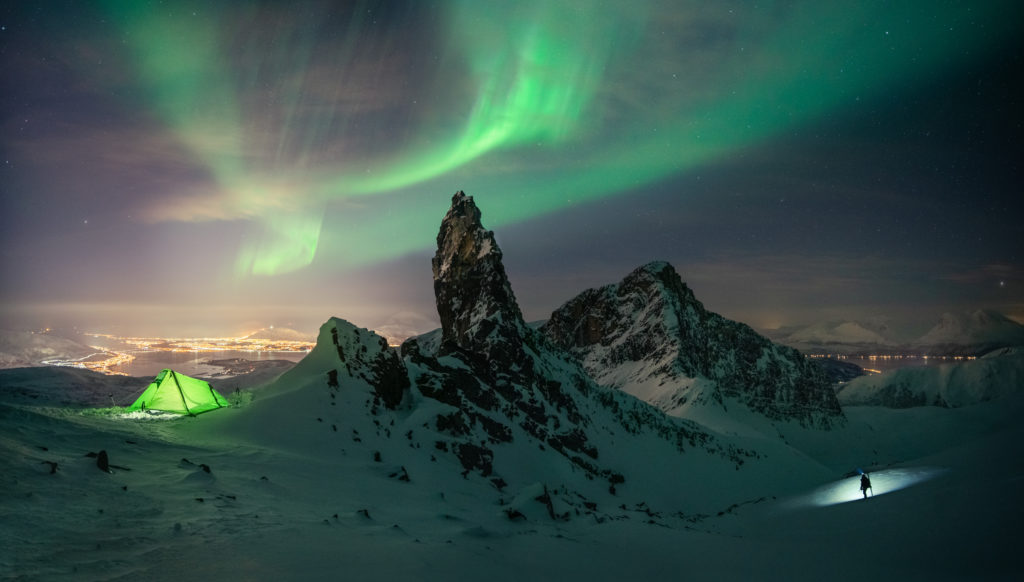
Is it about luck?
I sometimes get comments on my social media along the lines of “you were so lucky” to see it. However, those that follow me closely, understand that there is a lot of work, passion and love in my images. They don’t come out of nowhere. Calculations, planning, a bit of disappointment, a dose of frustration.. and finally achieving what you dream of. A good aurora photo is a good photo, even without the aurora, I always say.
Virgil Reglioni is one of the guides for the tour company Wandering Owl in Tromsø. They are one of the smaller of the many companies offering guided northern lights tours in Tromsø. Virgil comes from the Grenoble area in the French Alps, but has spent several winter seasons in Tromsø. His photo skills he has learned himself, with some amazing results. He was part of the 2021 Best Northern Light photographer of the year collection (By Capture_The_Atlas). A photography from Senja Island is France’s candidate for the World Photography Cup in 2022. We all follow his instagram feed.
Frequently asked questions
The Tooth is not called that, in fact we haven’t bothered to find out what it’s really called. But it’s part of a section of the island of Kvaløya that is particularly mountainous and rugged, with Alpine peaks and valleys. From a high point in Tromsø City, you can see these mountains clearly.
Florian and Vergil are experienced in ski mountaineering. Since they live in Tromsø during winter, they are also well informed about the snow situation and most particularly they are aware of the current avalanche danger. Finally, they also have the outdoor gear needed and know how to use it. Only experienced skiers and winter campers should try something similar.
You have good chances of spotting the Northern Lights from just before autumn equinox (around September 20th) to just after spring equinox (around the 20th of March). In February, you have real daylight for many hours, but it still dark in the most intense Northern Lights hours, from 6pm to about 1am.
